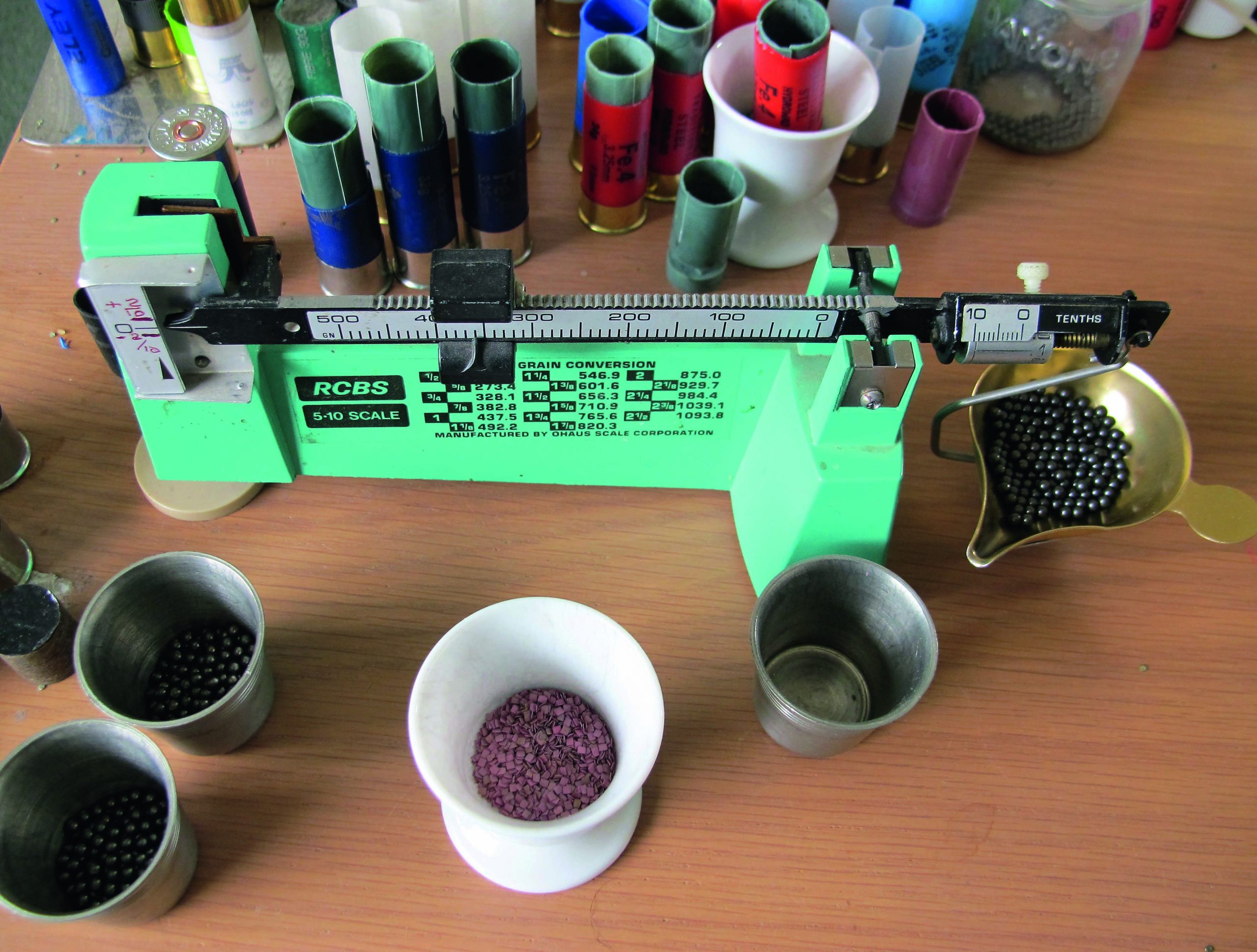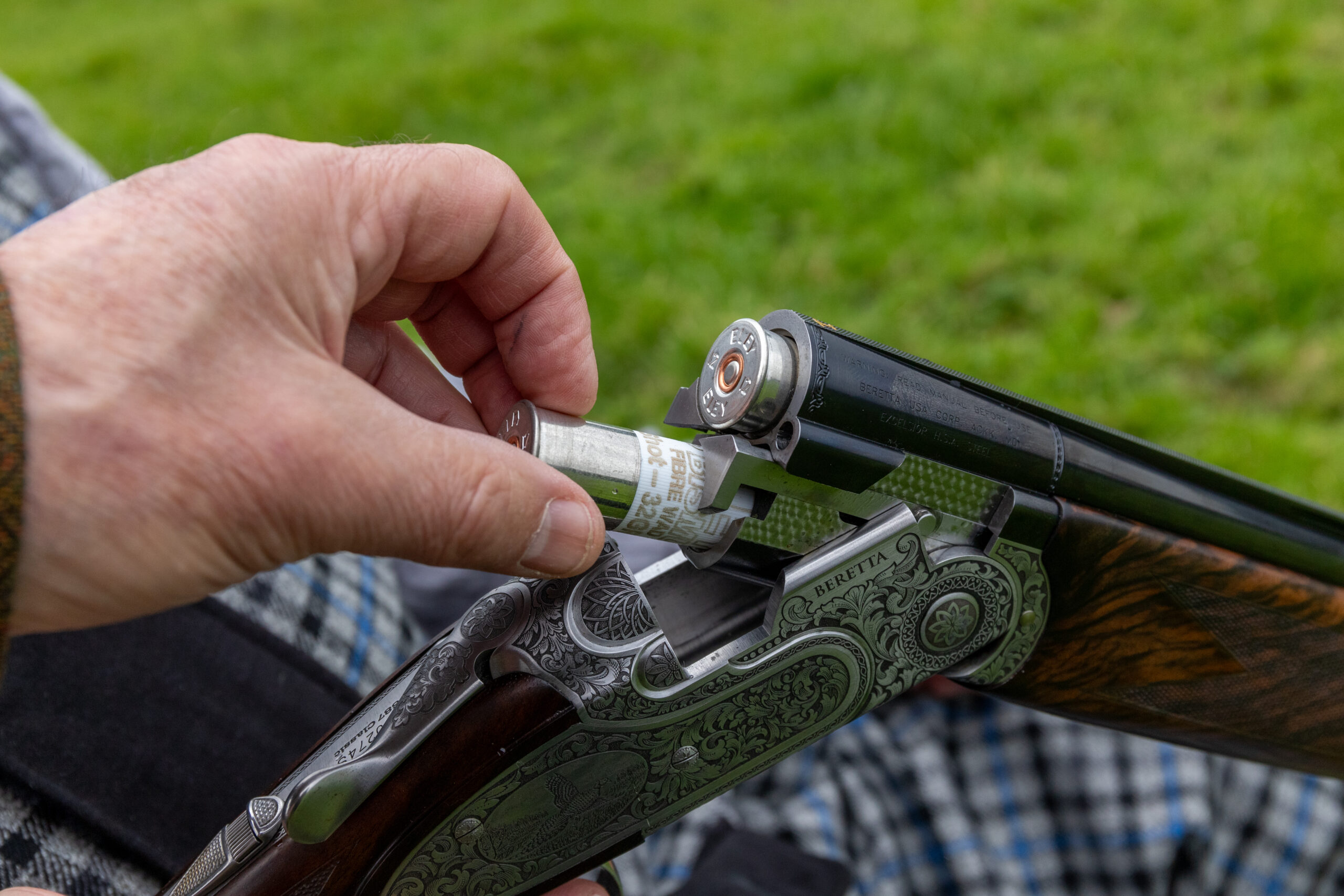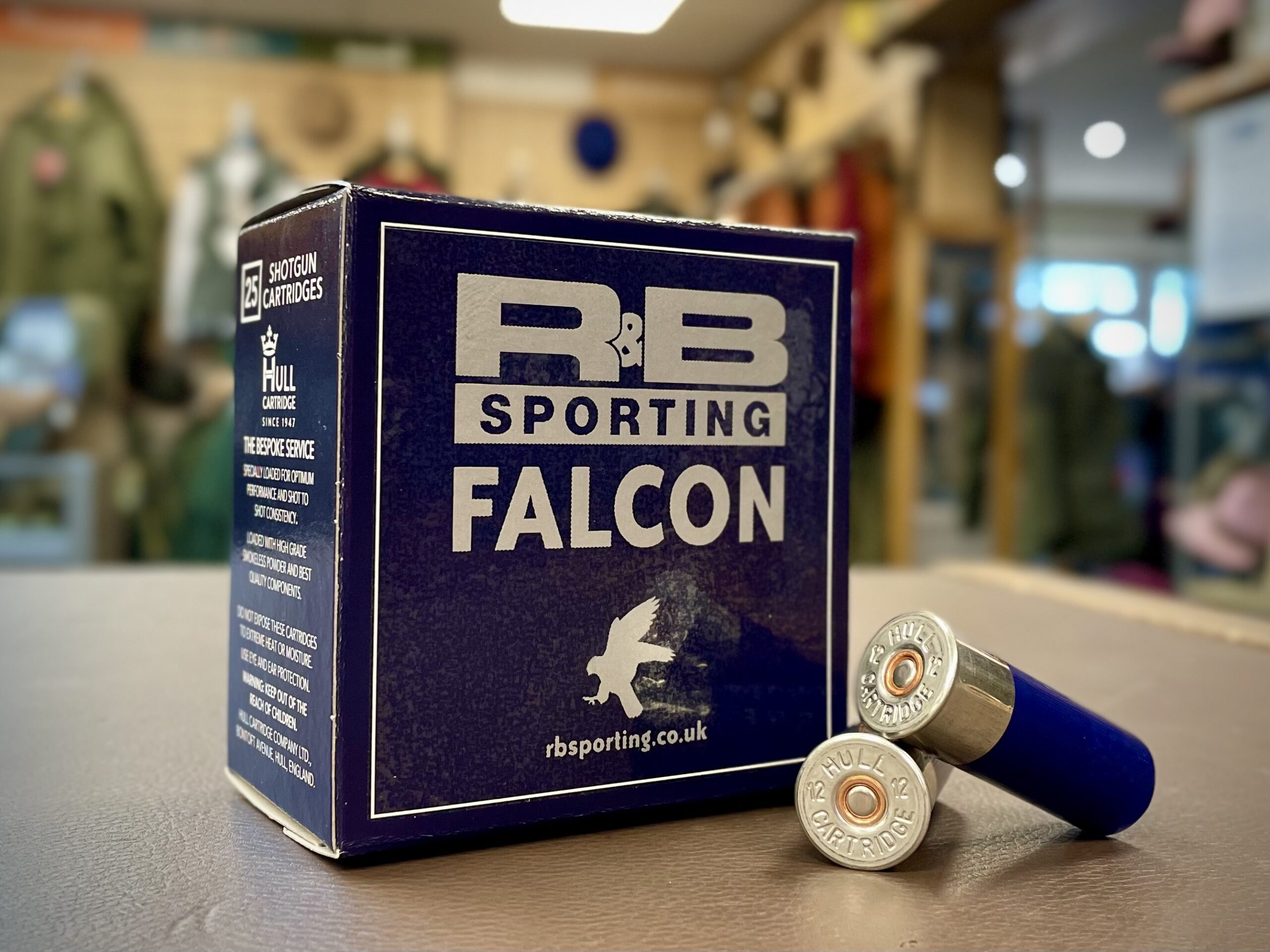Testing shotgun ammunition – Richard Atkins shares his process
Richard Atkins takes you through the stages involved in how to test shotgun ammunition and utilising meaningful analysis

Richard uses reloading scales for checking shot and powder weight during cartridge tests
Shotgun ammunition performance is something that has interested me since my youth and still does. Some may not understand why this is so but therein is the key: the more testing you carry out, the more differences you will spot. You must then ponder why some cartridges perform differently from others. This still is what makes the topic much more interesting than it might at first appear.
It is definitely a case of the more you discover the more you come to realise that there is always more to learn. That’s primarily how and why my interest is retained after many years of testing, more than 40 of them as part of my job.
The test procedure of testing shotgun ammunition is fairly straightforward. However, to make the results you achieve meaningful, especially if seeking to fairly compare one load with another – as when choosing a different brand or perhaps trying a budget price option – it is necessary to be meticulously thorough to arrive at a true comparison. A quick couple of shots at a pattern plate, which may ‘look OK’, can suffice if that’s all you wish for. Meaningful tests that will show the true relative performance between shotgun ammunition requires some additional input.
More on shotgun ammunition
- Sustainable ammo: why you should try it and make up your own mind
- Steel shot vs lead shot – the hard facts about steel shot
- How to store shotgun cartridges legally and safely
Pattern tests
In my case, the tests I conduct have long been based on testing any new cartridges that come on to the market so that readers can see how they perform. I obtain proof reports from the Birmingham Proof Laboratory for pressure, velocity, consistency and the recoil level – but you don’t need these for pattern testing.
Patterns are the single most significant of all the performance criteria and is something most shooters could undertake for themselves. Those with little or no patterning experience may wonder why pattern test at all. Whenever I hear, or read, such remarks it tells me straight away that person – however brilliant they may be and successful at what they do – has not done a great deal of meaningful pattern testing; it really is that simple.

The number of pellets in cartridges can vary
Some may ask “why bother, when I always buy the best shotgun ammunition”. That’s a fair point. If you choose wisely from the best shotgun ammunition available – as in known, highly successful brands at top level, or from reading the cartridge tests in Sporting Gun – and you also know from shooting them at the most demanding targets you are likely to meet, you don’t have so much to gain from spending the time required. I like to see for myself how well one type or brand compares in my guns, but that is personal preference.
The more important point for me is where some think there is little difference between brands and, more concerning, between budget and premium cartridges. Any such comment instantly displays a clear lack of understanding of what the differences should be.
A browse through comments on Facebook and internet shooting forums will soon reveal the usual suspects with remarks such as: “They all go bang; point them in the right direction and any cartridge will kill any target you aim at.” And another favourite: “Premium cartridges are a rip-off; it’s just a way to charge more for a fancy-looking shell with a taller, shiny metal head.”
It is very easy, and accurate, for me to say that whenever you read such piffle, please move on quickly and seek more informed comment. It is so very easy to prove such remarks as totally inaccurate that you can safely discard them.
In fact, just a few shots of each type on a pattern plate – without even doing the meticulous parts of more precise testing – will suffice to show the difference between budget and premium cartridges. Doing even this much may encourage you to do more meaningful tests too.
What is involved?
Do remember that is pellets that break target, not percentages. However, pattern percentages reveal how well the cartridge distributes the pellets in the shot load to produce what, we hope, is a reasonably regular, effective pellet distribution. That’s what makes best use of those pellets by improving the chances of adequate strikes.
Remember also that there will always be some unevenness in all patterns; as Gough Thomas, the great technical gun writer and former Shooting Times gun editor, wrote: “Pepper pot patterns only ever appear on pepper pots.” This was to help explain that a) no two will be the same, and b) the distribution will never be even from the centre to the edge.

Measuring pellets with a micrometer
What is more important is an absence of void patches where a target centred within the pattern could, theoretically, escape. It is therefore the lack of too many areas of pellet-free white space in your patterns that helps assess more effective patterns.
The methodology I employ is devised to make a full evaluation of key performance parameters, such that they are comparable with my previous test. To this end I have used the same gun for more than 30 years. It is a top grade semi-automatic – with steel receiver and so is robust and of a good weight – which helps with reducing felt recoil. Pattern testing can be surprisingly punishing with a fixed breech gun.
The gun is a Winchester Super X-1: has a 30in Trap barrel bored improved modified (¾). It has standard (short) forcing cones, standard barrel size of 0.729in (18.5mm) and 2¾in (70mm) chamber length. The reasons for this choice of specification are:
- The standard bore size works well with felt and fibre wad cartridges as well as all plastic wad types
- Being fixed choke bored as part of the barrel, there is no chance of mixing up an interchangeable choke
- Improved modified is the ideal choke for most cartridge test comparisons (except for Skeet cartridges **) because:
a) it is sufficiently tight to show if a cartridge is capable of achieving the nominal pattern percentage for this choke constriction (65% at 40 yards)
b) it allows for the closer patterning, premium cartridges to show their capabilities by exceeding the nominal pattern percentage that sometimes exceed full choke (70%) density. - The 2¾in (70mm) chamber helps get the best from the most popular cartridge length of 70mm. It also allows 65mm to 67.5mm cartridges to be used. Clay shooting guns are unlikely to have 2½in (65mm) chambers anyway, so my tests will reflect realistic test circumstances.

This device tests hardness of lead shot; its crush value (CV)
Note: New guns today, for clays and game, will often have 3in (76mm) chambers. These may perform a little differently from the results I obtain; hopefully not too significantly but, depending upon wad type, the difference may be greater. In worst-case scenarios, some shot balling can arise with fibre wad loads in 3in chambered guns firing shorter length cartridges.
This is an entire topic on its own but I mention it as a key reason why shooters should, ideally, pattern-test their own gun/choke/cartridge combination if only to be sure any fibre wad cartridges they use do not suffer pattern disruption or shot balling.
** I have a separate, 26in long Skeet bored barrel for testing Skeet cartridges
Quality matters
Shot quality will determine the target breaking/killing performance of any shotgun ammunition. Other components matter, of course, but low-grade shot in a high-grade wad with best-grade powders will not produce a second barrel trap, nor a high pheasant cartridge.
Things that define shot quality are:
- Hardness: this is largely dependent on percentage of antimony in the lead mix
- Size: how close the shot is to the stated size
- Size consistency: how well graded the shot is for consistent size
- Sphericity: round shot flies truer for longer

Lead pellets from a budget cartridge after a crush value test
I check hardness using a shot crush device. This is simply a known weight falling a known distance on to lead pellets placed on the anvil, on to which the steel weight is dropped. This gives a Crush Value (CV) that, by measuring how much the shot is crushed, indicates the antimony content:
Budget cartridges will have 2% to 2.6% antimony; mid-range around 3.5% to 4%. Premium loads are seldom under 4.5% and can go up to 7%, with 5% to 6% being a typical ‘top-grade’ mix found in top competition-grade Trap loads for Universal Trench, Olympic Trap and Helice and FITASC Sporting.
Shot diameters are measured with a micrometre as a necessary part of checking the CV figure: more are checked to find maximum and minimum size range.
Without exception, the very best and most consistent, very hard double- and triple-graded lead shot will be found in the premium brands from leading makers with a huge track record of major international competition wins – including World Championships and Olympic events.
load indicates a more
regular pattern and no issues
Meaningful results
For results to be meaningful and fit for fair comparison of one cartridge to another, it is essential to know what was actually in the shotgun ammunition tested. It’s not enough to take as read the shot size being precisely as stated on the carton, nor the shot load weight precisely the same in every cartridge. Both affect the true pellet count per cartridge so directly affect the percentages results recorded on and calculated from the pattern plate.
Charts can tell you that 28g of UK No 7.5 (2.3mm) shot equals 392 pellets but it’s not unusual for a combination of slightly different shot size and load weight to result in a different actual pellet count.
I always weigh several shot loads, so as to arrive at an average, counting these samples to obtain the true pellet count. A recent test of a 28g No 7.5 (2.3mm) shot cartridge gave a pellet count per cartridge of 416. If I had used chart figures this would have given almost 6% error in calculations that could produce a falsely high pattern percentage. Note that the difference between nominal modified (½) choke and improved modified (¾) is 5% at 40 yards.
Having analysed the shot loads, I also check powder loads for weight and consistency, and making a note of wad type and weight.
Having listed the shot loads, weights and hardness and so on, the pattern test figures are required: this can be done before or after content analysis.

Richard compares Remington Premier and Winchester Silver cartridge patterns
Pattern testing
I conduct my pattern tests at 40 yards: the long established industry standard. Forty yards works well because it is a sufficient distance at which patterns reveal their true potential. It is sufficient for tight shooting cartridges to be readily identified; as will those cartridges not patterning so closely.
Testing at 30 yards is fine for specific reasons, such as finding a good first barrel choke/cartridge combination for first barrel Down-The-Line or automatic ball trap and a general set-up for a targets on a Sporting layout. It is also handy for checking more open chokes for game and pigeon shooting.
Almost all reasonable shotgun ammunition, including decent budget loads, will perform quite well at 30 yards; a few 40-yard patterns will clearly show how much the budget patterns open out in that extra 10 yards.
With more choke they should tighten up a little but, a budget cartridge cannot match a premium shotgun ammunition at longer range; that is a useful lesson to be learned at the pattern. That is why I use the tried and tested 40 yards; it is more walking between shots but gives useful results for comparison.
If you are often tempted to take a rather more distant shot while in the field, do pattern your gun/cartridge combination at the longer range. If you might be tempted by 50-yard quarry, put a shot or two on the pattern plate at 50 yards; this will clearly show how patterns become thinner at range, some very much so.

Richard uses a surveyor’s tape to set out markers
I use two 4ft by 4ft steel pattern plates that allow me to shoot two patterns at a time, saving time and distance walked. Five patterns is the least number recommended for meaningful average results, so six is good.
You quickly learn why five is a minimum because no two patterns are the same. Also, it is rare to get exactly the same percentage for each test pattern shot from the same batch of cartridges. That’s why the process is so labour-intensive and time-consuming, and why so few people have actually done what I consider ‘meaningful’ pattern testing. This can even include gun reviewers who tell us how good the patterns with a particular gun and/or choke are.
I use a surveyor’s tape measure to set out my pattern-testing distances with marker posts set in the ground, with those markers at 20, 30, 40 and 50 yards. I use 20 yards for Skeet cartridge and Skeet choke tests, as well as for checking point-of-impact results for guns.
I use a non-drying white paint on the plates and for each pattern and draw a 20m and 30in circle around the bulk of the pellets on the plate. These are then counted, with each pellet mark crossed through as counted, for both the inner 20in circle, then the annular outer segment between the 20m and 30m circles.
These are recorded, averaged and the pattern percentages and central density (CD) calculated. CD indicates those cartridges that produce what some term a ‘hot centre’ core pattern; that is, higher percentage in centre) The pictures on this page will hopefully clarify the process.
This is as much as can be crammed into this article. If you would like more information, or clarification, ask the Editor; he may find it worth looking into later. Meanwhile, perhaps some readers will feel a desire to know how their gun and favourite cartridges actually perform.










